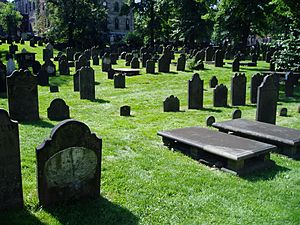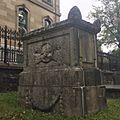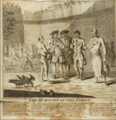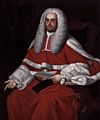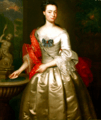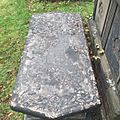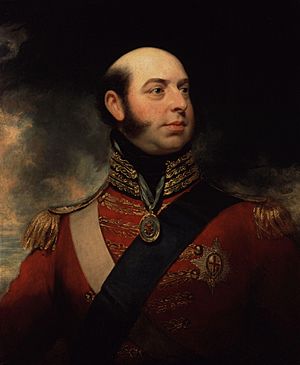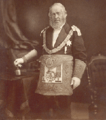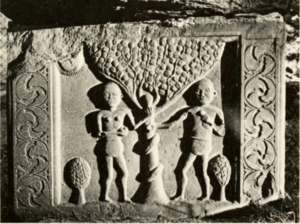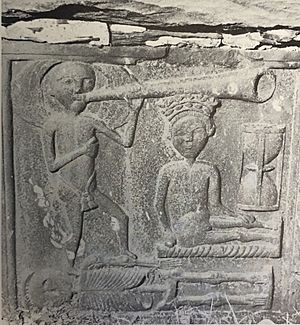Old Burying Ground (Halifax, Nova Scotia) facts for kids
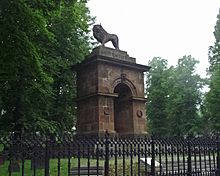
|
|
| Lua error in Module:Location_map at line 420: attempt to index field 'wikibase' (a nil value). | |
| Details | |
|---|---|
| Established | 1749 |
| Location | |
| Country | Canada |
| Type | Closed |
| Owned by | St. Paul's Church (Halifax) |
| No. of graves | 12,000+ |
| Official name: Old Burying Ground National Historic Site of Canada | |
| Designated: | 1991 |
| Type: | Provincially Registered Property |
| Designated: | 1988 |
The Old Burying Ground is a very old cemetery in Halifax, Nova Scotia, Canada. It is also known as St. Paul's Church Cemetery. You can find it in Downtown Halifax, where Barrington Street and Spring Garden Road meet.
Contents
- History of the Old Burying Ground
- Prominent tombstones
- Notable People Buried Here
- Sculptor James Hay
- The Old Burying Ground in Books
- Images for kids
History of the Old Burying Ground
The Old Burying Ground was started in 1749. This was the same year that Halifax was founded. It was the first place where people in the town could be buried. For many years, it was the only cemetery for everyone in Halifax, no matter their religion.
In 1793, the cemetery was given to the St. Paul's Church. It officially closed in 1844. After that, a new cemetery called Camp Hill Cemetery was used for burials.
Over time, the Old Burying Ground became a bit run down. But in the 1980s, a group called the Old Burying Ground Foundation helped restore it. They still take care of the site today and offer tours in the summer. They are also working to fix the old grave markers from the 1700s.
About 12,000 people were buried here over the years. Today, there are around 1,200 headstones. Many others were buried without a stone, or their stones have been lost.
One famous person buried here is British Major General Robert Ross. He led the attack on Washington D.C. in 1814, where the White House was burned. He was killed in battle a few days later in Baltimore.
Diverse Burials
The cemetery holds the graves of many different people who lived in early Halifax.
- Mi'kmaq People: Four Mi'kmaq individuals are recorded as being buried here, including a Mi'kmaw Chief Francis. Their graves are unmarked.
- Black Nova Scotians: There are 167 recorded Black Nova Scotians buried in unmarked graves. Many arrived with New England Planters or as Loyalists after the American Revolution. Some also came as War of 1812 refugees. Reverend William Furmage, a missionary who started the first school for Black students in Halifax, has a grave marker.
The Welsford-Parker Monument
The most noticeable monument in the cemetery is the Welsford-Parker Monument. It looks like a Triumphal arch and stands at the entrance. This monument celebrates a British victory in the Crimean War. It was built in 1860, even though the cemetery had closed 16 years earlier.
This arch was the first public monument in Nova Scotia. It is also the fourth oldest war monument in Canada and the only one in North America for the Crimean War. It was built by George Lang. The monument is named after two men from Halifax, Major Augustus Frederick Welsford and Captain William Buck Carthew Augustus Parker. They both died in a battle during the Siege of Sevastopol (1854–1855). This was the last grave marker placed in the cemetery.
In 1938, a monument was added for Erasmus James Philipps. He was one of the earliest known settlers of Nova Scotia (around 1721) and was buried here. He also started Freemasonry in Canada.
The Old Burying Ground was named a National Historic Site of Canada in 1991. It was also recognized as a Provincially Registered Property in 1988.
Prominent tombstones
-
Lt. Col James Fullarton, died 1834, Battle of Waterloo
-
Lt. Col John James Snodgrass, died 1841, Battle of Waterloo
-
Capt. Erasmus James Philipps monument, died 1760. He was part of the 40th Regiment of Foot and the Nova Scotia Council.
Notable People Buried Here
Early Halifax Settlers (1749–1776)
Many of the first people who helped establish Halifax are buried here.
-
John George Pyke's father John Abraham, died 1751, during the Dartmouth massacre.
-
William Paget, a Shakespearean actor, died 1752.
-
Mary, daughter of naval officer John Rous, died 1775.
-
Jonathan Belcher (jurist), died 1776. He was involved in the Halifax Treaty with the Mi'kmaq in 1761.
-
Catholic Priest Pierre Maillard was buried nearby.
-
Jonathan Binney, died 1807. He signed the Halifax Treaty with the Mi'kmaq people in 1761.
- Mary Morris, wife of Charles Morris (surveyor general).
- James Brenton.
- Honourable William Nesbitt.
- Priscilla Ball, a Black servant, died 1791. Her grave is unmarked.
- Mi'kmaw Chief Francis, died 1781. His grave is unmarked.
Those from the Siege of Louisbourg (1745)
Some people who helped establish Halifax had come from Cape Breton. They had been part of the British capture of Louisbourg in 1745.
-
Joseph Gerrish, died 1774. He was also wounded in the Battle of Grand Pré and signed treaties with the Mi'kmaq.
-
Winckworth Tonge, died 1792. He also fought in other important battles.
American Revolution Era
Many people who supported the British during the American Revolution came to Halifax. They were called Loyalists.
Military Figures
-
Hibbert Newton Binney, died 1842. He was an Ensign in the Royal Nova Scotia Volunteer Regiment.
-
Lt. John Stuart, died 1835. He was part of the 71st Regiment of Foot, Fraser's Highlanders.
- Peter Etter, died 1794. He was a Loyalist and friend of future President John Adams.
- John F. T. Gschwind (died 1827), a surgeon for Hessian soldiers.
- Charles Grant (military officer) (died 1785), from the 42nd Regiment of Foot. He fought in several wars, including the American Revolution. His grave is unmarked.
Loyalists from Boston
Many Loyalists from Boston moved to Halifax after the American Revolution.
-
William Brattle, died 1776. He was the Attorney General of Massachusetts and a very wealthy man. His gravestone is lost.
-
John Howe, died 1835. He was the father of famous Nova Scotian Joseph Howe.
-
Rebecca Byles Almon, died 1852. She was the wife of a surgeon from the Battle of Bunker Hill.
- Benning Wentworth (loyalist), died 1808. He was the provincial secretary of Nova Scotia.
- Martha Howe, wife of John Howe and mother of Joseph Howe.
- Jonathan Sterns, died 1798.
Boston Patriot
-
Benjamin Kent – a lawyer who freed the first enslaved person in the United States. He was also the first patriot Attorney General of Massachusetts.
Loyalists from New York
-
Margaret (Inglis) Halliburton, daughter of Bishop Charles Inglis. She supported education for Black Nova Scotians.
-
Lawrence Hartshorne, died 1822. He was a Quaker who helped Black Nova Scotians move to Sierra Leone in 1792.
French Revolutionary Wars (1792–1802)
During these wars, Prince Edward was stationed in Halifax. He personally honored several soldiers who died there.
Prince Edward Commemorations
- Lt. Benjamin James, died 1797, while trying to rescue people from a shipwreck.
- Major Charles Domville, died 1798.
- Charles Thomas, died from friendly fire.
- James Brace Sutherland, a 16-year-old midshipman who died in a storm in Halifax harbour in 1798.
- Benjamin Etter – Prince Edward's honorary aide-de-camp.
Other Burials from this Period
Napoleonic Wars (1803–1815)
Battle of Trafalgar
Peninsular War
-
Architect John Westmacott, died 1816. He was wounded in the Siege of Badajoz (1812).
-
Eliza Ussher, wife of Commodor Sir Thomas Ussher, died 1835. Sir Thomas took Napoleon Bonaparte into exile.
War of 1812
-
Major-General Robert Ross (British Army officer), died 1814 leading troops during the Battle of Baltimore.
-
William Hughes, died 1813. He helped Prince Edward design St. George's Round Church.
-
Sgt. Richard Smith, from the 104th (New Brunswick) Regiment of Foot. He was wounded five times in the Siege of Fort Erie.
-
Esther Rowlands, wife of Dr. David Rowlands (surgeon), a naval surgeon.
- Lieut. Col. John-Fowell Goodridge, died 1819.
Battle of Waterloo
-
Lt. Col James Fullarton, died 1834, fought in the Battle of Waterloo.
-
Lt. Col John James Snodgrass, died 1841, fought in the Battle of Waterloo.
Military Officers (1816–1844)
-
Charles Francis Norton died 1835. He was the son-in-law of Sir Colin Campbell.
- Hon. William Cropton, died 1838.
- Commander John George Deware, died 1830.
- John Thompson, a surgeon, died 1818.
- William Pepperell, Quarter Master, died 1837.
Other Notable People
-
William Bowie (merchant), died 1819. He was killed in the last duel in Nova Scotia.
-
John Lawson, died 1828. He was the father of William Lawson, who was the first president of the Bank of Nova Scotia.
-
Peter McNab, who McNabs Island is named after.
-
Susan Cunard, wife of Samuel Cunard, died 1828.
-
Hon Stedman Rawlins, died 1830. He was a plantation owner and president of the Council of the Island of St. Christopher.
-
Rev Archibald Gray, died 1831. He served St. Matthew's United Church (Halifax) for 35 years.
- Mary Welsford, mother of Parker Welsford (from the Welsford-Parker Monument).
- Charles Morris (1759–1831).
- William Annand, father of another William Annand.
- Dr. Samuel Head, the first doctor born in Nova Scotia.
- Robert Collins (died 1812) and his wife Sarah (died 1812). A place called Collins Grove in Dartmouth is named after them.
- Honorable Charles Hill (jurist) died 1825.
Sculptor James Hay
Some of the gravestones in the cemetery were made by stone carvers from London and the local area. One of the first stone sculptors was James Hay (1750–1842). He likely made the gravestone for Richard Bulkeley's wife, Mary.
On one side of Mary's gravestone, Hay carved the angel Gabriel blowing a trumpet. This symbolizes new life. The religious words say: "In a moment, in a twinkling of an eye at the last trump; for the trumpet shall sound, and the dead shall be raised incorruptible, and we shall be changed" (1 Corinthians 15:52).
On the other side of the gravestone, there is a picture of the garden of Eden. The words say: "For as in Adam all die, even so in Christ shall all be made alive." (1 Corinthians 15:22). This image came from an old book called "The Child's Guide" (London, 1725).
The Old Burying Ground in Books
The Old Burying Ground is mentioned in Lucy Maud Montgomery's book, Anne of the Island. In the story, Anne moves to Kingsport (which is based on Halifax, Nova Scotia) and lives in an apartment that looks out over "Old St. John's Cemetery," which is the Old Burying Ground.
Anne describes the cemetery as a "dim, cool, green place where winds were fond of purring." She walks through the grassy paths, reading the old, detailed messages carved on the gravestones. She notes that most of the old tombstones are made of rough brown or gray stone. Some have carvings of skulls and cross-bones, often with an angel's head too. Many stones are broken or fallen over, and some of the words are hard to read because time has worn them away. Anne describes the graveyard as very full and leafy, with elm and willow trees. She imagines that those buried there sleep peacefully, undisturbed by the busy city sounds nearby.
Images for kids
-
William Brattle, died 1776. He was the Attorney General of Massachusetts and a wealthy silversmith. His gravestone is lost.


